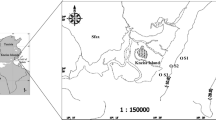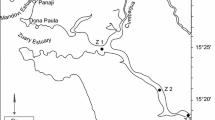Abstract
We measured abundance and biomass of 3 major groups of microzooplankton, i.e. tintinnids, naked ciliates and copepod nauplii, at 21 stations in the Inland Sea of Japan in October 1993, January, April and June 1994. The average abundance of the microzooplankton over the entire Inland Sea of Japan ranged from 2.39×105 indiv. m−3 in January to 4.00×105 indiv. m−3 in April. Ciliated protozoans, i.e. tintinnids plus naked ciliates, numerically dominated the microzooplankton. The average biomass of the microzooplankton was exceedingly high in October (8.62 mg C m−3) compared to that in the other months (2.06, 2.79 and 2.68 mg C m−3 in January, April and June, respectively). The ciliated protozoans also dominated in terms of biomass except in October, when copepod nauplii were more important. Estimated production rate of the microzooplankton was highest in October (average: 6.02 mg C m−3d−1) and followed in order by June, April and January (1.94, 1.14 and 0.54 mg C m−3d−1, respectively). Due to higher specific growth rate, the production rate by the ciliated protozoans far exceeded that by the copepod nauplii. The trophic importance of the microzooplankton in the pelagic ecosystem of the Inland Sea of Japan was assessed by estimating carbon flow through the microzooplankton community.
Similar content being viewed by others
References
Aizawa, Y. (1985): Microzooplankton. p. 237–240. InProduction Potential of Marine Bioresources and Marine Environment (First Stage), Sci. Tech. Agency, Tokyo (in Japanese).
Aizawa, Y. (1987): Microzooplankton. p. 313–316. InProduction Potential of Marine Bioresources and Marine Environment (Second Stage), Sci. Tech. Agency, Tokyo (in Japanese).
Burkill, P. H. (1982): Ciliates and other microplankton components of a nearshore food-web: standing stocks and production processes.Ann. Inst. Océanogr.,58, 335–350.
Buskey, E. J. (1993): Annual pattern of micro- and mesozooplankton abundance and biomass in a subtropical estuary.J. Plankton Res.,15, 907–924.
Capriulo, G. M. and E. J. Carpenter (1983): Abundance, species composition and feeding impact of tintinnid microzooplankton in central Long Island Sound.Mar. Ecol. Prog. Ser.,10, 277–288.
Cole, J. J., S. Finlay and M. L. Pace (1988): Bacterial production in fresh and saltwater ecosystems: a cross-system overview.Mar. Ecol. Prog. Ser.,43, 1–10.
Dale, T. and P. H. Burkill (1982): “Live counting”—a quick and simple technique for enumerating pelagic ciliates.Annls Inst. Oceanogr., Paris (N.S.),58, Suppl., 267–276.
Dohi, K. (1982): Seasonal change of tintinnid community in Funka Bay.Bull. Plankton Soc. Japan,29, 77–87 (in Japanese with English abstract).
Dolan, J. R. and D. W. Coats (1990): Seasonal abundances of planktonic ciliates and microflagellates in mesohaline Chesapeake Bay waters.Estuar. Coast. Shelf Sci.,31, 157–175.
Endo, T. (1970): On primary production in the Seto Inland Sea.J. Fac. Fish. Anim. Husb., Hiroshima Univ.,9, 177–221 (in Japanese with English abstract).
Endo, T. and T. Okaichi (1977): Productivity of phytoplankton. p. 318. InProductivity of Biocenoses in Coastal Regions of Japan. JIBP Synthesis, Vol. 14, ed. by Hogetsu et al., Univ. Tokyo Press, Tokyo.
Environmental Agency (1995):Environment of the Seto Inland Sea (in Japanese).
Fenchel, T. (1968): The ecology of marine microbenthos. III. The reproductive potential of ciliates.Ophelia,5, 123–126.
Fenchel, T. (1987):Ecology of Protozoa—The Biology of Free-Living Phagotrophic Protists. Springer-Verlag, Berlin.
Finlay, B. J. (1978): Community production and respiration by ciliated protozoa in the benthos of a small eutrophic loch.Freshwat. Biol.,8, 327–341.
Gaines, G. and M. Elbrachter (1987): Heterotrophic nutrition. p. 224–268. InThe Biology of Dinoflagellates, ed. by F. J. R. Taylor, Blackwell Sci. Publ., Oxford.
Heinbokel, J. F. (1978): Studies on the functional role of tintinnids in the Southern California Bight. 1. Grazing and growth rates in laboratory cultures.Mar. Biol.,47, 177–189.
Hirota, R. (1977): Zooplankton. p. 299–308. InProductivity of Biocenoses in Coastal Regions of Japan. JIBP Synthesis, Vol. 14, ed. by K. Hogetsu et al., Univ. Tokyo Press, Tokyo.
Ikeda, T. and S. Motoda (1978): Estimated zooplankton production and their ammonia excretion in the Kuroshio and adjacent seas.Fish. Bull.,76, 357–366.
Joh, H. and S. Uno (1983): Zooplankton standing stock and their estimated production in Osaka Bay.Bull. Plankton Soc. Japan,30, 41–51.
Kamiyama, T. (1994): The impact of grazing by microzooplankton in northern Hiroshima Bay, the Seto Inland Sea, Japan.Mar. Biol.,119, 77–88.
Kimoto, K., S. Uye and T. Onbe (1986): Growth characteristics of a brackish-water calanoid copepodSinocalanus tenellus in relation to temperature and salinity.Bull. Plankton Soc. Japan,33, 43–57.
Kiørboe, T. (1993): Turbulence, phytoplankton cell size, and the structure of pelagic food webs.Adv. Mar. Biol.,29, 1–72.
Leakey, R. J. G., P. H. Burkill and M. A. Sleigh (1992): Planktonic ciliates in Southampton water: abundance, biomass, production, and role in pelagic carbon flow.Mar. Biol.,114, 67–83.
Liang, T., S. Uye and T. Onbe (1996): Population dynamics and production of the planktonic copepods in a temperate eutrophic inlet. I.Centropages abdominalis.Mar. Biol.,124, 527–536.
Montagnes, D. J. S., D. H. Lynn, J. C. Roff and W. D. Taylor (1988): The annual cycle of heterotrophic planktonic ciliates in the waters surrounding the Isles of Shoals, Gulf of Maine: an assessment of their trophic role.Mar. Biol.,99, 21–30.
Nomura, H., T. Ishimaru and M. Murano (1992): Microzooplankton assemblage and its seasonal variation in Tokyo Bay, Japan.La mer,30, 57–72 (in Japanese with English abstract).
Parsons, T. R., Y. Maita and C. M. Lalli (1984):A Manual of Chemical and Biological Methods for Seawater Analysis. Pergamon Press, Oxford.
Putt, M. and D. K. Stoecker (1989): An experimentally determined carbon: volume ratio for marine “oligotrichous” ciliates from estuarine and coastal waters.Limnol. Oceanogr.,34, 1097–1103.
Revelante, N. and M. Gilmartin (1983): Microzooplankton distribution in the Northern Adriatic Sea with emphasis on the relative abundance of ciliated protozoans.Oceanol. Acta,6, 407–415.
Revelante, N. and M. Gilmartin (1987): Seasonal cycle of the ciliated protozoan and micrometazoan biomass in a Gulf of Maine estuary.Estuar. Coast. Shelf Sci.,25, 581–598.
Revelante, N., M. Gilmartin and N. Smodlaka (1985): The effects of Po River induced eutrophication on the distribution and community structure of ciliated protozoan and micrometazoan populations in the northern Adriatic Sea.J. Plankton Res.,7, 461–471.
Robertson, J. R. (1983): Predation by estuarine zooplankton on tintinnid ciliates.Estuar. Coast. Shelf Sci.,16, 27–36.
Sanders, R. W. (1987): Tintinnids and other microzooplankton—seasonal distributions and relationships to resources and hydrography in a Maine estuary.J. Plankton Res.,9, 65–77.
Sherr, E. B. and B. F. Sherr (1987): High rates of consumption of bacteria by planktonic ciliates.Nature,325, 710–711.
Sherr, E. B., F. Rassoulzadegan and B. F. Sherr (1989): Bacterivory by pelagic choreotrichous ciliates in coastal waters of the N.W. Mideterranean Sea.Mar. Ecol. Prog. Ser.,55, 235–240.
Smetacek, V. (1981): The annual cycle of protozooplankton in the Kiel Bight.Mar. Biol.,63, 1–11.
Stoecker, D. K. and J. D. Capuzzo (1990): Predation on protozoa: its implications to zooplankton.J. Plankton Res.,12, 891–908.
Stoecker, D. K. and D. A. Egloff (1987): Predation byAcartia tonsa Dana on planktonic ciliates and rotifers.J. Exp. Mar. Biol. Ecol.,110, 53–68.
Stoecker, D. K., A. E. Michaels and L. H. Davis (1987): Large proportion of marine planktonic ciliates found to contain functional chloroplasts.Nature,326, 790–792.
Stoecker, D. K., M. W. Silver, A. E. Michaels and A. E. Davis (1988): Obligate mixotrophy inLaboea strobila, a ciliate which retains chloroplasts.Mar. Biol.,99, 415–423.
Suzuki, R. and T. Ishimaru (1992): An improved method for the determination of phytoplankton chlorophyll using N,N-dimethylformamide.J. Oceanogr. Soc. Japan,46, 190–194.
Tatara, K. (1981): Productivity of the inshore fishing ground: changes of productivity in the Seto Inland Sea (Review).Bull. Nansei Reg. Fish. Res. Lab.,13, 135–169 (in Japanese with English abstract).
Uye, S. (1980): Development of neritic copepodsAcartia clausi andA. steueri. II. Isochronal larval development at various temperatures.Bull. Plankton Soc. Japan,27, 11–18.
Uye, S. (1982): Population dynamics and production ofAcartia clausi Giesbrecht (Copepoda: Calanoida) in inlet waters.J. Exp. Mar. Biol. Ecol.,57, 55–83.
Uye, S. (1988): Temperature-dependent development and growth ofCalanus sinicus (Copepoda: Calanoida) in the laboratory.Hydrobiologia,167/168, 285–293.
Uye, S. (1991): Temperature-dependent development and growth of the planktonic copepodParacalanus sp. in the laboratory.Bull. Plankton Soc. Japan,Spec. Vol., 627–636.
Uye, S., Y. Iwai and S. Kasahara (1983): Growth and production of the inshore marine copepodPseudodiaptomus marinus in the central part of the Inland Sea of Japan.Mar. Biol.,73, 91–98.
Uye, S., H. Kuwata and T. Endo (1987): Standing stocks and production rates of phytoplankton and planktonic copepods in the Inland Sea of Japan.J. Oceanogr. Soc. Japan,42, 421–434.
Verity, P. G. (1985): Grazing, respiration, excretion and growth rates of tintinnids.Limnol. Oceanogr.,30, 1268–1282.
Verity, P. G. (1986a): Grazing of phototrophic nanoplankton by microzooplankton in Narragansett Bay.Mar. Ecol. Prog. Ser.,29, 105–115.
Verity, P. G. (1986b): Grazing rates of natural tintinnid populations of Narragansett Bay.Mar. Ecol. Prog. Ser.,29, 117–126.
Verity, P. G. (1987): Abundance, community composition, size distribution, and production rates of tintinnids in Narragansett Bay, Rhode Island.Estuar. Coast. Shelf Sci.,24, 671–690.
Verity, P. G. and C. Langdon (1984): Relationships between lorica volume, carbon, nitrogen, and ATP content of tintinnids in Narragansett Bay.J. Plankton Res.,66, 859–868.
Verity, P. G. and D. K. Stoecker (1982): Effects ofOlisthodiscus luteus on the growth and abundance of tintinnids.Mar. Biol.,72, 79–87.
Author information
Authors and Affiliations
Rights and permissions
About this article
Cite this article
Uye, Si., Nagano, N. & Tamaki, H. Geographical and seasonal variations in abundance, biomass and estimated production rates of microzooplankton in the Inland Sea of Japan. J Oceanogr 52, 689–703 (1996). https://doi.org/10.1007/BF02239460
Received:
Revised:
Accepted:
Issue Date:
DOI: https://doi.org/10.1007/BF02239460




